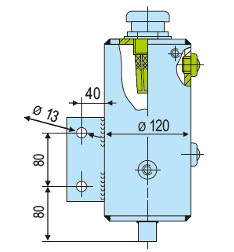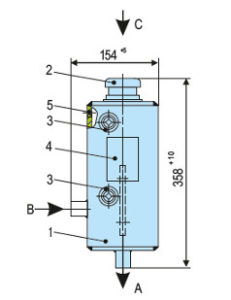Project Description
- Designed for varied applications due to
construction in stainless steel with
borosilicate sight-glasses suitable for
highly corrosive media - Reliability in operation due to the design of
combined filling and ventilation filter in the
hand refill pump - Construction design for operating
pressure up to 200 °C - Discharge of leakage is achieved due to
integrated overflow design - To monitor the fluid volume a level switch
can be installed instead of sight glass
- Quench fluid systems are employed:
- To absorb leakage
- To monitor the leakage rate (e.g. through
periodic reading of the level in the tank) - To lubricate and to cool the outboard
mechanical seal in a tandem arrangement - To prevent icing
- To protect against dry running
- To stabilize the lubricating film
- To exclude air from the media in order to prevent a reaction with oxygen in the air
- Chemical industry
- Petrochemical industry
- Oil and gas industry
- Refining technology
- Pulp and paper industry
- Food and beverage industry
- Install the quench fluid tank approx. 1 … 2 m (3.3
… 6.6 ft) above the mechanical seal. Install
connection pipes to the mechanical seal with low
flow resistance. Pipes must vent automatically in
the direction of the tank. It is imperative that air
pockets are prevented. The minimum filling level
must always be above the connection socket at
the side (in the case of the thermosiphon
principle). - Quench fluid systems can be operated in two
different modes: - Dead-end quench (Plan 51):
Quench fluid from an elevated tank. The
characteristic feature of this principle is that no
heat is dissipated by the system. - Circulation (Plan 52):
Quench fluid from an elevated tank; external tank,
pressureless; thermosiphon or forced circulation.
In this case heat is dissipated by the circulation.
Cooling capacity by convection is minimal,
however.
- Circulation in accordance with API 682 / ISO
21049: Plan 51, Plan 52 - Quench fluid supply system is employed for
applications in sealing systems with a wide
variety of operating parameters for supplying
quench fluid to double and tandem mechanical
seals. They act as a convenient fluid reservoir.
The exchange of fluid takes place by the
thermosiphon principle or by forced circulation,
for example with a pumping screw. The
QFS2000 stainless steel tank is equipped with
sight-glasses for monitoring the MIN/MAX level
and can be fastened with a lug fixture. The
leakage overflow can be selectively discharged.


